| |
Black History: The Clinton 12
By Jeaneane Payne
February 1, 2022
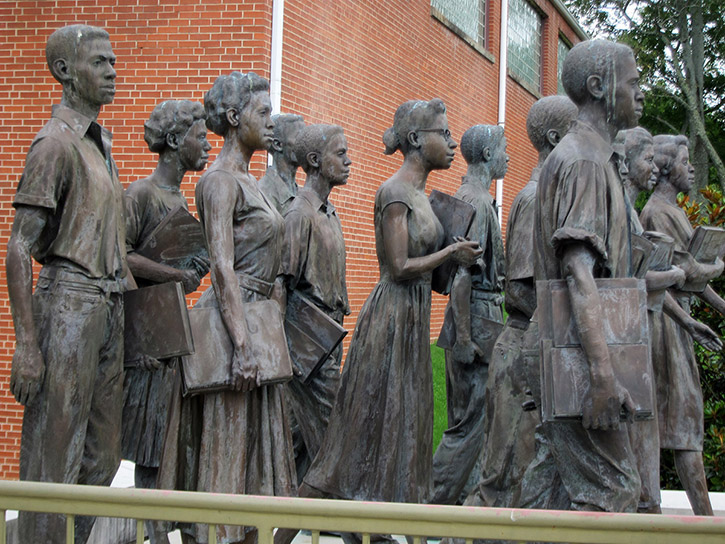
The Clinton 12 included: Maurice Soles, Anna Theresser Caswell, Alfred Williams, Regina Turner Smith, William R. Latham, Gail Ann Epps Upton, Ronald Gordon “Poochie” Hayden, JoAnn Crozier Allen Boyce, Robert Thacker, Bobby Cain, Minnie Ann Dickey Jones, and Alvah McSwain; image by Jeaneane Payne
|
On August 27, 1956, twelve African American young people from Clinton, Tennessee became the first students to desegregate a public high school in the South. The courageous students who entered Clinton High School on that historical day became known as "The Clinton 12".
Over the following few months their presence in a primarily white school became the basis for very unsettling events which made national news. The Clinton 12 story depicts how a diverse community set aside their differences and came together to do the right thing.
In Brown v. Board of Education, the Supreme Court had ruled the that the doctrine of “separate, but equal” was unconstitutional in public education. In a subsequent case, Brown v. Board of Education II (1955), the court ordered that public schools must be integrated with all “deliberate speed.”
Following the Brown II decision, Judge Robert Taylor, who had previously ruled against the plaintiffs in McSwain v. Anderson County, reversed his decision and ordered the school board to end segregation prior to the 1956-57 school year.
During the summer of 1956, community leaders, parents, teachers, and students had a series of meetings in preparation for integration.
Historically, although segregation was practiced in public spaces and in daily life, blacks and whites in Clinton, Tennessee, got along well and life was peaceful. Clinton residents for the most part considered themselves law-abiding citizens, and whether they liked the ruling or not, they agreed to accept it.
Registration day was peaceful. The first day of school was peaceful. The peacefulness did not last.
Racist segregationists and Ku Klux Klan members John Kasper and Asa Carter arrived in Clinton with intent to stir up trouble.
On the second day of school, Kasper convinced a few locals to protest integration outside the school, but they left after a few minutes.
When the story made national news, racist segregationists from across the country began arriving in town. At first only 50 people came to town. As news spread, there were 500, then thousands.
Hundreds of national and international media rushed into town. The protest in Clinton became the lead story on nightly network news shows.
The speeches of Kasper and Carter fanned the flames of hatred. There were nightly mobs. Hooded KKK members began driving through the Foley Hill neighborhood and setting off dynamite.
Clinton High teachers and administrators became targets of abuse with anonymous phone calls and threatening letters.
The efforts of Kasper and Carter caused some name-calling and spitballs in Clinton High School classrooms and hallways initially, but eventually, students got used to integration.
The repulsiveness continued on the outside, however, and Black students had to have police escorts home.
While in Clinton, John Kasper worked to establish a White Citizens Council, but many residents refused to join ranks with his efforts. He also attempted to form a Junior White Citizens Council at Clinton High School, but only a few students joined. His intervention, however, did provoke some white students to torment Black students with taunts, hair-pulling, and stepping on heels.
Principal Brittain recruited Jerry Shattuck and members of the football team to patrol the hallways and keep the peace. Their positive example set a peaceful tone within the school.
On Labor Day weekend, outsiders continued to flood into town. There were no interstate highways in those days, and US Route 25W passed directly down Clinton’s Main Street, making it an easy destination.
With the ever-increasing crowd, tensions mounted, and local officials requested assistance from Governor Frank G. Clement. Clinton had a small police force, so forty home guard men were deputized to keep the peace in the interim. Most of them were former veterans who carried their own weapons. They set aside their personal feelings on school desegregation in order to fight off mob rule.
Later that evening, the first reinforcements arrived with a parade of more than one hundred state troopers who drove into town and circled the town square. The head patrolman was Officer Greg O'Rear who stood 6 ft, 8 in. He climbed out of his car, slung his shotgun over his shoulder, and said "Boys, it's all over." At that point, the unruly crowd dispersed.
The following day, 635 National Guardsmen arrived with seven tanks and other military vehicles.
The governor’s order was an unpopular decision, according to some, but the town of Clinton was put under martial law for two weeks.
When the National Guard left town, acts of violence continued, and by November tension was at an all-time high.
December 5th was Election Day. Clinton First Baptist pastor Rev. Paul Turner was concerned about their safety, so he decided to escort the students down Foley Hill to the school.
As he headed back to church, White Citizen Council members jumped him and beat him. Bystanders were shouting, “Kill him!” When no one would help, Clinton resident Vivian Shoopman jumped in and began pulling arms away from him as blood streamed down his face. Turner was able to escape the group, and several attackers were arrested.
Turner’s actions became an example to the citizens of Clinton. The attack became a turning point that unified a loosely organized community undecided on the issue of segregation.
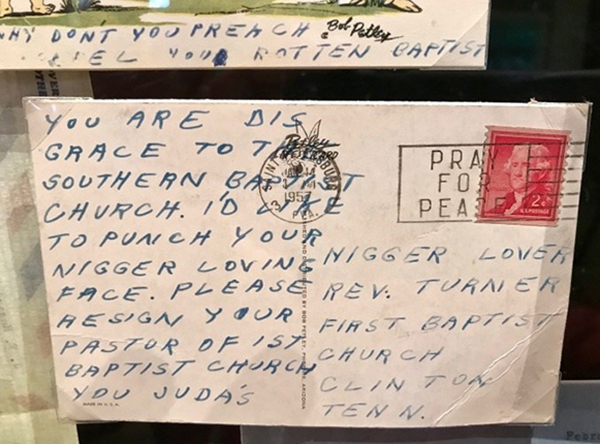
Letter to Rev Turner, First Baptist Church; image taken at Green McAdoo by Jeaneane Payne
|
Turner began to receive both hate mail as well as letters of affirmation and support.
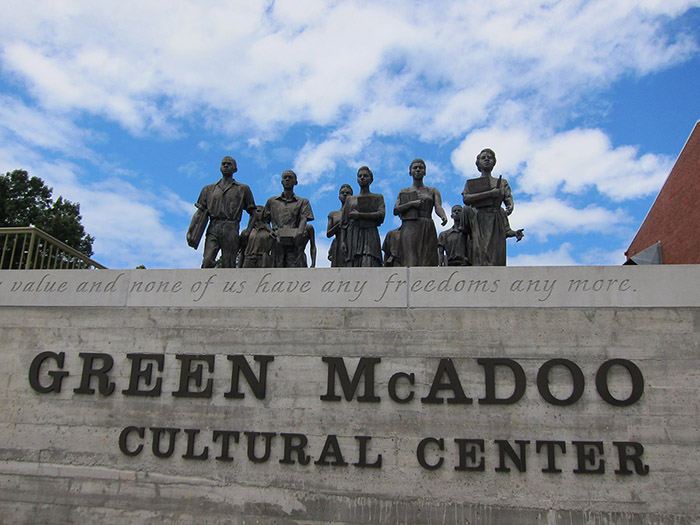
Inscription reads "None of us have anything of any value and none of us have any freedoms any more." - image by Jeaneane Payne
|
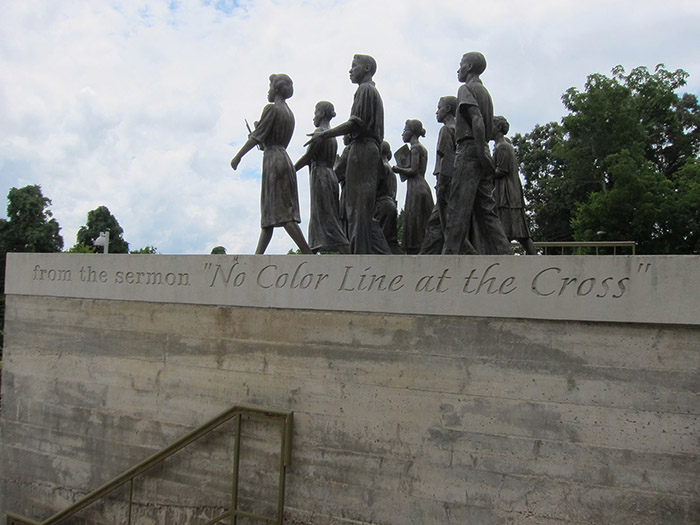
Side view of Green McAdoo Cultural Center entrance; image by Jeaneane Payne
|
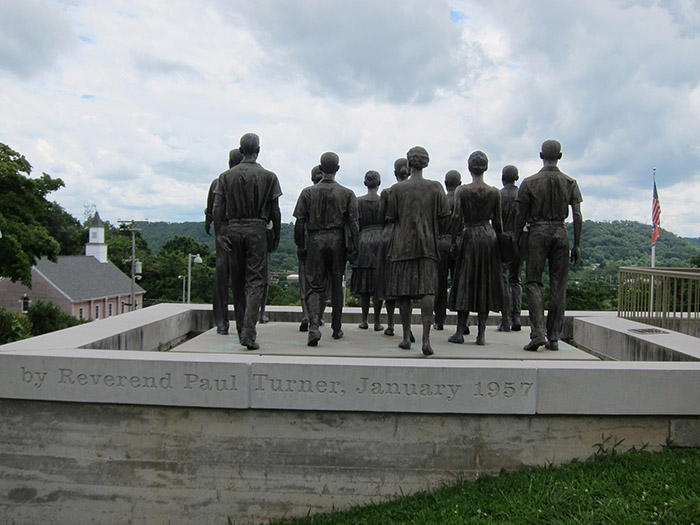
Back view of Green McAdoo Cultural Center entrance; image by Jeaneane Payne
|
The following Sunday, the First Baptist sanctuary was standing room only. Rev. Turner preached a powerful message of hope and reconciliation entitled “No Color Line at the Cross.”
His sermon included these words: “Here in Clinton we are not especially against integration, we are not especially against segregation, but we are positively and defiantly against the disintegration of our community and our body politic that we cherish above all things, realizing that where anarchy prevails, none of us have anything of any value, and none of us have any freedoms anymore.”
The controversy over desegregation had transitioned from a legal issue to a moral issue.
On Election Day, all pro-segregation candidates were defeated.
On May 17, 1957, Bobby Cain became the first African American to graduate from a court-ordered state-supported high school in the South.
When reporters caught up with him after commencement exercises, Cain commented, “It’s been a rough year, and I wouldn’t want to go through it again. But I’m not sorry that I went to Clinton High School.”
Before he could leave the school grounds, Cain was assaulted.
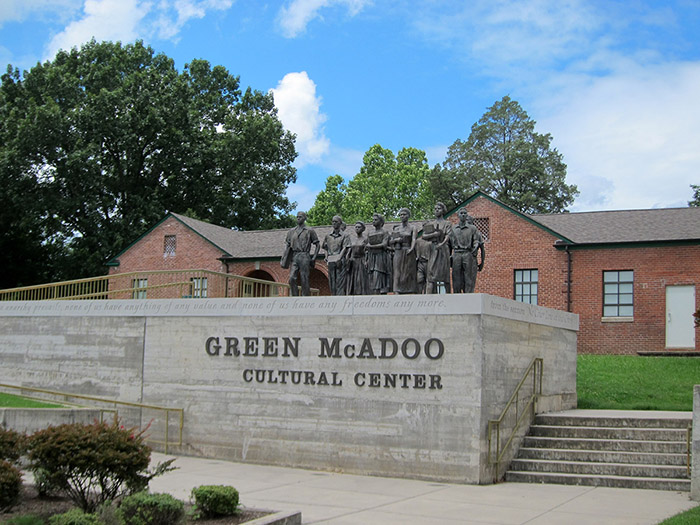
Green McAdoo Cultural Center; image by Jeaneane Payne
|
This profound moment in the Civil Rights movement has been preserved with the Green McAdoo Cultural Center in Clinton, Tennessee. This part of Black History deserves to receive national recognition for its role in the ongoing struggle for the equality of all Americans.
As visitors arrive at the Green McAdoo Cultural Center, they are greeted by a moving sculpted display entitled The Clinton 12 – Walking into History. A dozen life-sized bronze statues portray the students as they made the historic walk from their neighborhood on Foley Hill to integrate Clinton High School.
The Clinton 12 Story begins with a video introduction in a 1950s period classroom.
Teacher Mrs. Theresa Blair narrates, educating visitors about life in the South during the Jim Crow era, the local McSwain v. Anderson County (1952) lawsuit, and its connection to the landmark Supreme Court ruling in the Brown v. Board of Education (1954) case.
Following the video, visitors walk into a large gallery that tells the Clinton 12 story by highlighting key events in the historical timeline with interactive videos and displays.
In another room, visitors can view the January 6, 1957, CBS broadcast of See It Now on the big screen. The episode entitled Clinton and the Law: A Study in Desegregation, was narrated and produced by Edward R. Murrow and Fred Friendly.
The news documentary is an invaluable primary source and time capsule that includes Judge Taylor’s ruling, John Kasper’s speech, an interview with senior Jerry Shattuck, commentary by Principal Brittain, and an excerpt of Rev. Turner’s sermon. The presentation is followed by an October 24, 1962, follow-up by Harry Reasoner on CBS Reports: The Other Face of Dixie.
Green McAdoo's guide, Jerry Shattuck, was a Clinton High School senior during the turbulent years. Shattuck used his position as student council president and captain of the football team as an opportunity to be a positive role model to his peers.
Former Clinton City Manager Steve Jones put it this way: “If my Uncle DJ (Brittain) said it once, he said it a half dozen times to me, ‘You know during those tough days in 1956, if it hadn’t been for Jerry Shattuck and his leadership role with the student body, I don’t know that Clinton would have ever survived. . . .”
Jerry Shattuck would later graduate from Princeton University, and become a successful attorney. He serves on the Clinton City Council to this day.
Acts of violence and intimidation continued in Clinton into the second year of desegregation. Two years later, in the early morning hours of October 5, 1958, Clinton High School was shaken by three explosions, estimated to be the result of 150 sticks of dynamite.
Anderson County Schools chose the vacant Linden Elementary in neighboring Oak Ridge as an alternate location to continue the school year. More than 200 volunteers from both communities went to work on the abandoned school and got it ready for occupancy in just three days. Classes resumed on October 9. On the first day of school at the new location, rival Oak Ridge High band played the Clinton High School alma mater to welcome the 900 black and white students and teachers as they stepped off their buses.
Evangelist Billy Graham helped raise money to rebuild the school during a five-day crusade in the Clinton High School gymnasium, with 5000 people in attendance.
No arrests were ever made in the school bombing.
The museum tour ends in an epilogue room that honors individuals who played central roles in the desegregation of Clinton High School. The walls are lined with photos of the Clinton 12 students and other honorable individuals who played key roles in the struggle.
The Clinton 12 : A Documentary Film is an award-winning production written and directed by Keith McDaniel and narrated by James Earl Jones. : A Documentary Film is an award-winning production written and directed by Keith McDaniel and narrated by James Earl Jones.
This 2006 documentary recounts the Clinton 12 story through archival photographs, video, and interviews with students and other members of the community who witnessed the events surrounding the desegregation of Clinton High School.
The film aired widely on PBS in 2008 and 2009. The DVD is available for purchase at Amazon.com.
Mt. Sinai Baptist Church
During the the period of mob violence and threats to their community, women and children slept in the basement of Mt. Sinai Baptist Church. Armed husbands and fathers would stand guard.
First Baptist Church
Rev. Paul Turner pastored Clinton First Baptist Church during desegregation. He preached his “No Color Line at the Cross” message at this location.
The Brave and Tragic Trail of Reverend Turner
Hoskins Drug Store
Hoskins Drug Store has served Clinton since 1930. Situated across Main Street from the Anderson County Courthouse, this historical pharmacy had a front row seat during the tumultuous desegregation of Clinton High School.
Visit the Green McAdoo Cultural Center online at greenmcadoo.org or on Facebook at facebook.com/greenmcadoo.
|

